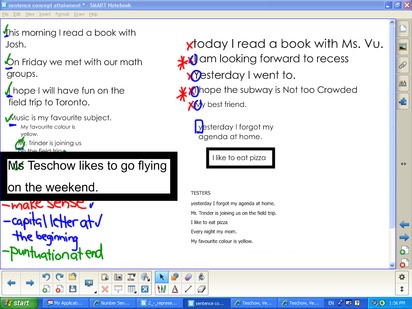
I had noticed that many of my students' writing included "sentences" that were either lacking a capital or punctuation at the beginning and end, or that simply did not make sense because they did not encapsulate complete thoughts. So, using my fabulous new IWB, I put together a wee little concept attainment lesson, hid each example and tester until I touched it, and away we went (see screen shot to the left).
Ahhh, but there is never just a “wee little” lesson when it comes to concept attainment; that is why it is such a powerful strategy!!!
Just as we had compiled a list of probable criteria based on the examples, and were beginning the testers, one of my students raised a pertinent point... You see, the students had noticed that all the examples on the left began with a capital letter, ended with a period, and “made sense”. These were indeed the critical aspects of the concept of a “sentence” I had hoped they would notice, and we listed them as necessary criteria for being in the left column. (See handwritten list on the bottom left of the screenshot).
But then, then came the tester, “I like pizza”, and my little friend, who is usually quite unfocussed, but who was extremely engaged with our little “guess my rule game” (another advantage of concept attainment is that even the most challenging students are drawn in by the game-like characteristic of this strategy) noted that it goes on the right (correct!) because it is “not about school, and all the ones on the left are about school” (OOPS!!!)
Yes, Ms. Teschow, that is what comes of not carefully constructing the data set and looking it over in advance to ensure it is demonstrative of the concepts you want to teach, and ONLY the concepts you want to teach!!!
Soooo.... I congratulated my little friend on her keen eye, and then quickly added another "yes" example (see black box on the left of the screenshot). I noted that although the previously listed examples indeed all had something to do with school, this new one certainly belonged on the left as well, therefore, we need not add “school stuff” to the criteria list. I then challenged her to explain why the pizza (black box on the right of the screen shot) did indeed NOT fit into the left column.
Happily, the student soon saw that in addition to not having anything to do with school, the pizza phrase was not a complete sentence, as it lacked a period.
The essence of “What makes a sentence?” was soon established, and students went off to write some sentences of their own, ensuring that each one began with a capital letter, ended with a period, and expressed a complete thought.
For those readers lucky enough to have a Smart Board in their classroom, please feel free to use the lesson below. (It is in Smart Notebook 11 format.)
| sentence_concept_attainment.notebook |


 RSS Feed
RSS Feed